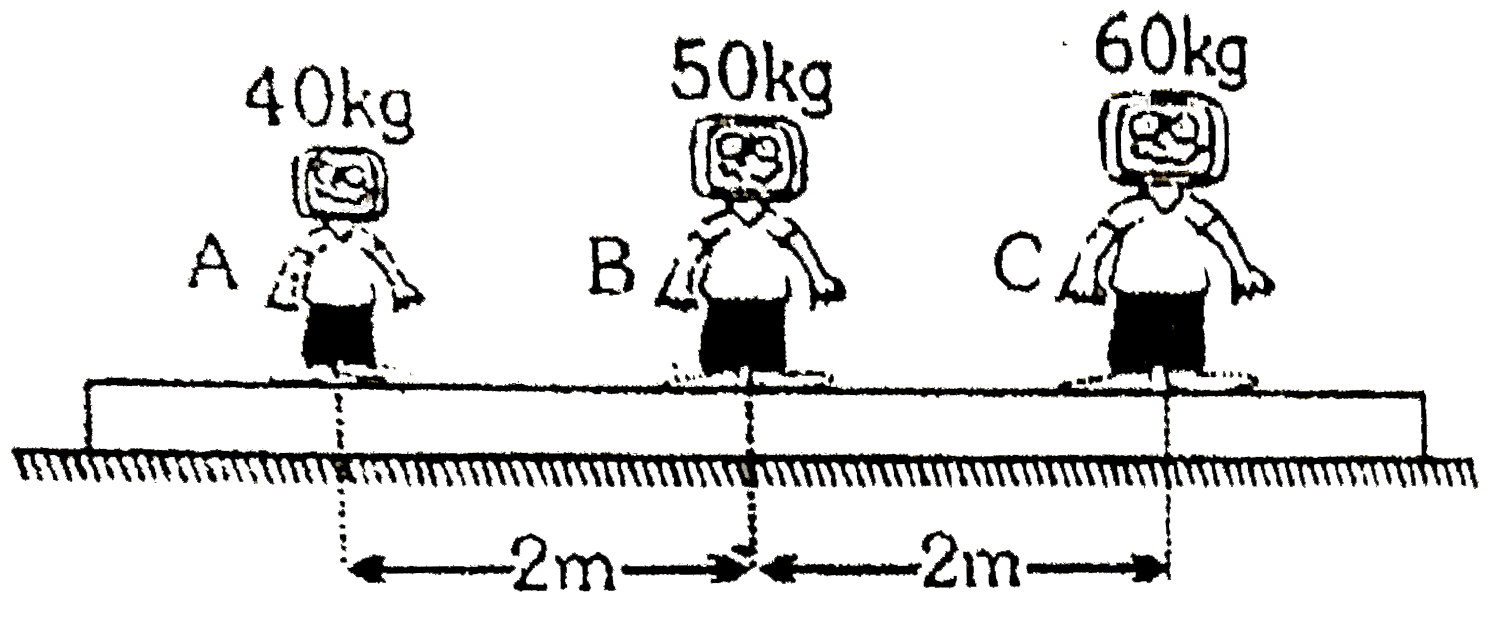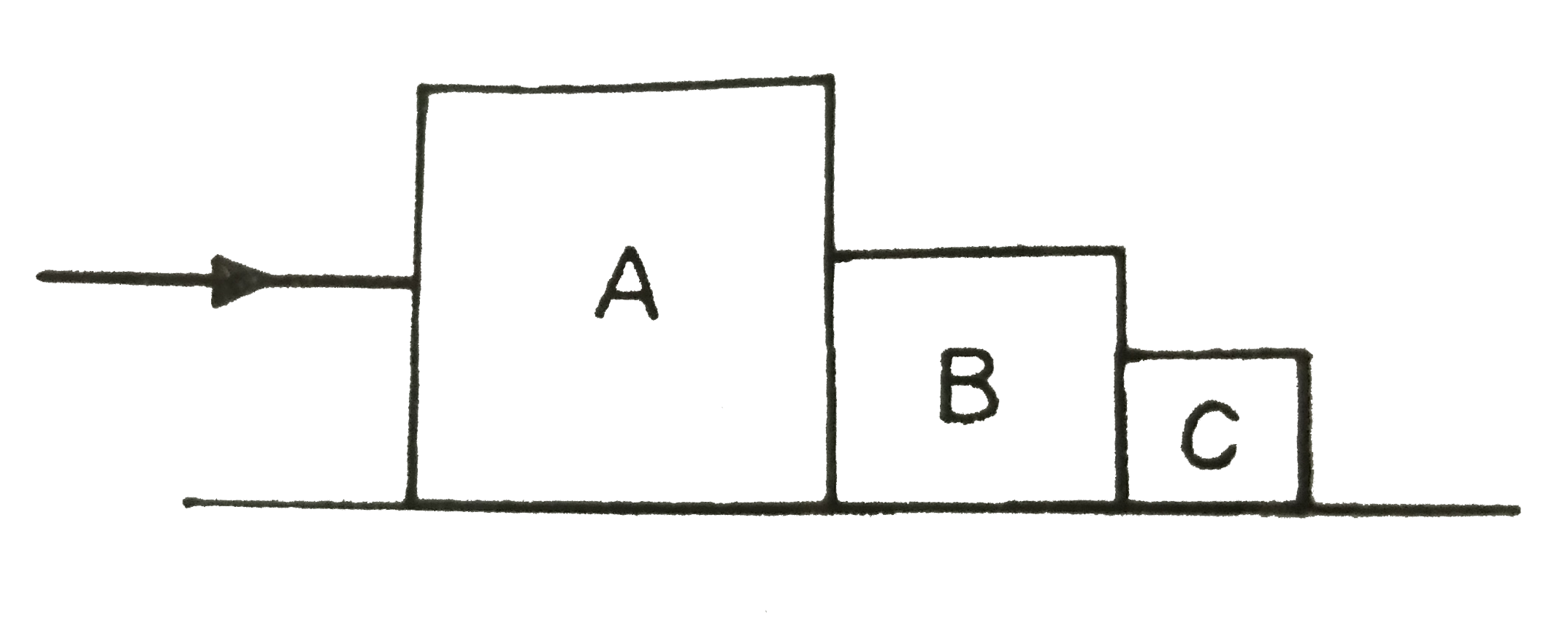Three blocks A,B and C are kept as shown in the figure. The coefficient of friction between A and B is 0.2, B and C I s0.1 C and ground is smooth. The mass of A,B and C are 3 kg , 2 kg and 1 kg respectively. A is given a horizontal velocity 10 m/s A,B and C always remains is contact i.e., lies as in figure. The total work done by friction during this process is 25xJ. Then find x.
 Solution in Telugu
Solution in Telugu
The correct Answer is:3
Step by step video, text & image solution for Three blocks A,B and C are kept as shown in the figure. The coefficient of friction between A and B is 0.2, B and C I s0.1 C and ground is smooth. The mass of A,B and C are 3 kg , 2 kg and 1 kg respectively. A is given a horizontal velocity 10 m/s A,B and C always remains is contact i.e., lies as in figure. The total work done by friction during this process is 25xJ. Then find x. by Physics experts to help you in doubts & scoring excellent marks in Class 11 exams.
Topper's Solved these Questions
- BOOK - AAKASH SERIESCHAPTER - WORK -POWER-ENERGYEXERCISE - PRACTICE SHEET (ADVANCED) (STRAIGHT OBJECTIVE TYPE QUESTIONS)36videos
WORK -POWER-ENERGY
- BOOK - AAKASH SERIESCHAPTER - WORK -POWER-ENERGYEXERCISE - ADDITIONAL PRACTICE EXERCISE (LEVEL -II LECTURE SHEET ADVANCED MATRIX MATCHING TYPE QUESTIONS)1videos
WORK -POWER-ENERGY
- BOOK - AAKASH SERIESCHAPTER - VISCOSITY EXERCISE - Questions for Descriptive Answers3videos
VISCOSITY
- BOOK - AAKASH SERIESCHAPTER - WORK POWER ENERGYEXERCISE - EXERCISE - 361videos
WORK POWER ENERGY
Similar Questions
The velocity of a particle of mass 10−2kg is given as →v=(2xˆu+3yˆj+4zˆk) m/sec (where x, y and z are in meter). The amount of work done by applied force in displacing a particle from (1m, 2m, 0) to (-1m, 3m, 1m) is …..
04:49View SolutionAn automobile of mass m accelerates, starting from rest while engine supplied constant power p. Match the following columns (after t sec).
 03:17View Solution
03:17View SolutionAn iron sphere of mass 20×10−3 kg falls through a viscous liquid with terminal velocity 0.5 m/sec. Find the terminal velocity of another iron sphere of mass 54×10−2 kg.
08:14View SolutionIf →A+→B=→Rand2→A+→B is perpendicular to →B then
03:17View SolutionIn the arrangement shown in figure mass of blocks A,B and C is 18.5 kg .8 kg and 1.5 kg respectively . The bottom surface of A is A is smooth while coefficient of friction that between block A and C is mu_(1) = 1//3 between B and floor is mu_(2) = 1//5 System is relased from rest r = 0 and pulley are light and friction Calculate acceleration of block A ,B and C
04:25View SolutionThree blocks A,B and C of mass 10 kg each are hanging on a string passing over a fixed frictionless pulley as shown in figure. The tension in the string connecting blocks B and C is (g=10m//s^(2))
02:36View SolutionThree man A, B & C of mass 40kg,50kg & 60kg are standing on a plank of mass 90kg, which is kept on a smooth horizontal plane. If A & C exchange their position then mass B will shift :-
 06:26View Solution
06:26View SolutionAs shown in figure A, B and C are 1 kg, 3 kg and 2 kg respectively. The acceleration of the system is -
04:41View SolutionBlock A and B of masses 5 kg and 10 kg are placed as shown in figure. If block A is pulled with 50 N. Find out acceleration of the A and B. If coefficient of friction between A and B is 0.5 and between B and ground is 0.4.
03:08View Solutionतीन गुटके A ,B तथा C जिनके द्रव्यमान क्रमशः 4 किग्रा, 2 किग्रा तथा 1 किग्रा है एक घर्षणहीन पृष्ट पर परस्पर संपर्क में रखे गए है। यदि 4 किग्रा के गुटके पर 14 न्यूटन का बल लगाया गया है तो A तथा B के बीच संपर्क बल होगा:
 04:16View Solution
04:16View Solution100 किग्रा द्रव्यमान का ब्लॉक A, 200 किग्रा द्रव्यमान के ब्लाक B पर रखा हुआ है तथा चित्र में दिखाए अनुसार एक दीवार से बंधा हुआ है। ब्लॉक A और B के बीच घर्षण गुणांक 0.2 तथा ब्लॉक B और जमीन के बीच घर्षण गुणांक 0.3 है। ब्लॉक B को गति देने के लिये न्यूनतम लगाया गया बल F होगा (g = 10 मी से−2)
07:53View SolutionThe mass of A and B blocks is 2 kg and 3 kg respectively The two blocks are placed in contact with each other on a smooth horizontal table [Figure 1.65].
View SolutionThree blocks A, B and C of masses 4 kg, 2 kg and 1 kg respectively, are in contact on a frictionless surface, as shown. If a force of 14 N is applied on the 4 kg block, then the contact force between A and B is
 04:34View Solution
04:34View SolutionBlock A and B of masses 5 kg and 10 kg are placed as shown in figure. If block A is pulled with 50 N. Find out acceleration of the A and B. If coefficient of friction between A and B is 0.5 and between B and ground is 0.4.
03:20View SolutionIn the arrangement shown in figure mass of blocks A,B and C is 18.5 kg .8 kg and 1.5 kg respectively . The bottom surface of A is A is smooth while coefficient of friction that between block A and C is mu_(1) = 1//3 between B and floor is mu_(2) = 1//5 System is relased from rest r = 0 and pulley are light and friction Calculate acceleration of block A ,B and C
03:20View Solution

